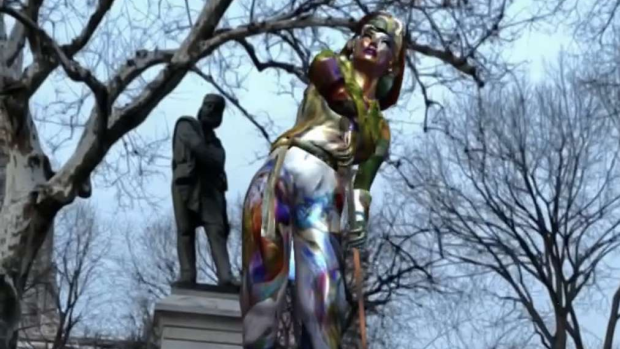An augmented reality project honors Women's History Month and provides a new view of New York’s public monuments

A digital sculpture created by NYU Tandon Industry Professor Carla Gannis. It is one of more than 30 gender-diverse digital sculptures that can be juxtaposed against physical statues of men across New York City as part of XRE’s #MakeUsVisible project.
If you’ve spent any time in Washington Square Park, you’ve probably noticed a bronze statue of a military figure poised to draw his sword. The statue depicts 19th-century Italian general Giuseppe Garibaldi, who fought during his country’s struggle for unification.
If you haven’t taken much notice, it could be because the Garibaldi statue is one of some 150 statues around New York City honoring historical male figures: only a handful, however, depict women. What would it look like, NYU Tandon Industry Professor Carla Gannis wondered, if Garibaldi was transformed into a mythic female avatar–fierce, empowered, ready to draw her own sword, and emblematic of the future.
This March, in celebration of Women’s History Month, the public can share her vision thanks to a project launched by the Extended Reality Ensemble (XRE), a group that came together in 2020 at the intersection of art, technology, and philosophy to address important societal concerns.
Gannis’s reimagined G@r1B@ldA! Is one of more than 30 gender-diverse digital sculptures that can be juxtaposed against physical statues of men across New York City as part of XRE’s #MakeUsVisible project, which runs until March 31 and invites viewers to listen to an audio tour as they follow an interactive map and use their mobile devices to view the augmented reality (AR) artworks.
In addition to G@r1B@ldA!, the works include:
- Excluded: Black Women in American History by Lauren Owen, a graduate of NYU Tandon’s Integrated Design & Media (IDM) program, in which Gannis teaches.
- Being Seen: ReSculpting South Asian History by Shehara Ranasinghe, an IDM grad
- New York Nails co-created by IDM Adjunct Professor Leah Roh
Members of the NYU Tisch community were also among the artists changing the face of the city’s monuments using Instagram AR filters, which allow users outside of New York City to view the digital creations and place them next to male sculptures in their own locations–in effect, launching a conversation between past and future.
“The goal of the project is to encourage users to consider public monuments and why representation in that realm matters,” said Gannis, who used an admittedly small dataset of photos of existing female-identified statues to train an AI application in creating G@r1B@ldA! “Despite enormous strides, we can’t take for granted that the work of the Women’s Movement is done. We have to continue to participate, advocate, and educate if we’re going to make ourselves visible.”

